Our Two-Story Houses: Becoming Ladders for Spiritual Ascent

Part of a yearlong series about building and builders inspired by the Torah cycle.
I’m a fan of two-story houses. I enjoy some separation from the busy “functional” part of the house, while my husband prefers the ease of having “practical” things accessible on one level. Our new ranch-style home seemed a perfect solution: single-level living with an upstairs perch – a sunny loft, my very own ‘’second story.” I love my little retreat in the sky filled with comfy furniture, books and music.
 But I rarely use it myself, and it’s impractical for me to invite others to join me there. Do I love my loft more in theory than in reality, or is getting up there just too much of a challenge to be useful? The only access to the loft is a heavy ladder that must be wrestled awkwardly into place each time we wish to ascend.
But I rarely use it myself, and it’s impractical for me to invite others to join me there. Do I love my loft more in theory than in reality, or is getting up there just too much of a challenge to be useful? The only access to the loft is a heavy ladder that must be wrestled awkwardly into place each time we wish to ascend.
I admit some “ladder envy” when engaging with this week’s Torah portion and the description of Jacob’s iconic vision (Vayeitzei). If only a mystical staircase would appear to connect the loft to the rest of our house. (While we’re asleep, no less!) And, to dive into Torah’s metaphor of connecting “above” with “below,” if only we all had easy tools for spiritual ascent.
Then again, maybe we do.
The Jacob we encounter this week doesn’t begin in a good place. He alienated his family and enraged his brother. He flees. As the sun sets and darkness descends, Jacob makes camp: he sets stones to protect his head and lays down for the night. There he experiences his famous dreamscape vision: the heavens open, a ladder appears and reaches skyward, angels ascend and descend, and the Divine Presence appears at the top. Jacob hears God promise to be with him wherever he goes. Jacob wakes and affirms God’s presence:
“Surely God was in this place and I did not know it. How awesome is this place! This is none other than the House of God, and this is the gate of heaven” (Gen. 28:15-17).
 Sulam Yaakov
Sulam Yaakov
We call it Sulam Yaakov, Jacob’s Ladder, although he himself neither builds it nor climbs it. More accurately, it is God’s ladder – to enlighten Jacob, to awaken him to God’s presence on earth. Narrowly read, we might think Jacob was shown only an isolated “place” (in Hebrew, makom) where heaven and earth connect. Indeed, rabbinic tradition makes much of that geographic place, associating it with the Akedah (binding of Isaac), Sinai, the Holy Temples and more.
But Jacob’s actions the next morning reveal a higher truth.
The ladder had disappeared and the “real world” remained as it was. Yet Jacob designates the now seemingly ordinary place as “none other than Beit El” (House of God). He further vows if God leads and protects Jacob, then Jacob will believe and dedicate himself and his possessions to God’s service (Gen. 28:20-22).
Tradition holds that Jacob’s vow still indicates his “conditional faith,” that he was still trying to bargain and even manipulate just as he had with the family he was fleeing. I offer a different read.
Building and Becoming
Jacob’s words indicate a radical shift in worldview. Torah’s “trickster” has been humbled. He no longer could believe that what happens “downstairs” is solely his domain. Rather, he was given to understand that even life’s basics (food, clothing, safety) depend on a Divine Source that is everywhere – in Hebrew, HaMakom (the Place).
What is it exactly that Jacob saw and understood?
Interestingly, the most mundane component of Jacob’s revelation is the clue. The existence of God, heaven and angels didn’t seem to be a surprise, nor should they be. After all, this was his family’s God: is Jacob not the grandson of Abraham and Sarah, son of Isaac and Rebecca?
What’s news to Jacob is the most ordinary part of the scene – the ladder, “Sulam Yaakov.” Jacob already knew there were two stories: he just needed to make the connection.
Our teaching then comes less from Jacob’s dream than from his twofold response to it: building and becoming. Jacob didn’t set out to build a scaffold, stairway or tower to the sky (like the Tower of Babel that went so wrong). Nor did Jacob pray for God to send another ladder when the first one disappeared. Rather, Jacob built a monument, a marker here on Earth, to remind and reconnect. He then vowed to remodel his life; in what he now understood the world to be – God’s place. Emotionally and spiritually, the builder, and the act of building, became the ladder.
“Wonderful story,” my rational mind says. “What does that mean for me?”
One more hint from the text:
 There’s No “I” in Heaven
There’s No “I” in Heaven
When Jacob woke and opened his eyes, he expressed astonishment: “Surely God was in this place and I did not know it” – in Hebrew, va’anochi lo yadati. Rendered in English, the Hebrew reads slightly differently: “… and I, I did not know.”
Rabbi Pinchas Horowitz reads Jacob’s bewilderment radically: “I did not know my I-ness.” “I did not know” isn’t merely an expression of surprise but a description of what Jacob experienced and an instruction for how to build.
We come to experience what’s “upstairs” precisely by learning how to not-know our Anochi, our own ego. As Lord Jonathan Sacks put it, we most experience holiness when we move beyond Self. We sense the “Thou” of divinity when we move beyond the “I” of egocentricity. Only as we move beyond our Self do we become truly open to the world and the Creator.
That’s the kind of Judaism we must build – a Judaism that encourages us to serve others, both for their sake and for the sake of moving beyond our own “I-ness.” Serving others is the way up. Only by working for the greater good, in the house where we already are, can we ourselves become ladders to access “upstairs.”
May we be granted the ability to seek Divinity in every place. May the call to build inspire us to serve. And may we be blessed with moments of Grace when ego fades (sometimes even despite ourselves) and we see ladders “upstairs” simply appear.


By Rabbi Bella Bogart; sketchnote by Steve Silbert.

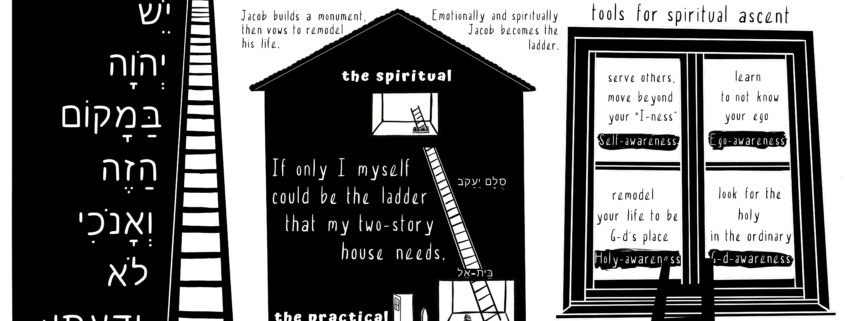
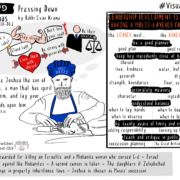
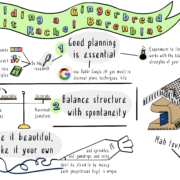

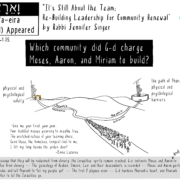

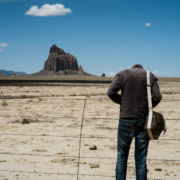


Trackbacks & Pingbacks
[…] Our Two-Story Houses: Becoming Ladders for Spiritual Ascent […]
Comments are closed.